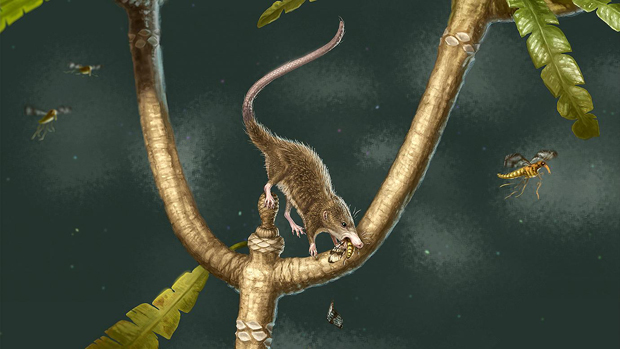Mammaliaforms Could Swallow Just Like Us
Microdocodon gracilis – Hyoid Bones
A team of international researchers have announced the discovery of a tiny, Middle Jurassic mammaliaform that was not much longer than a pencil and had thigh bones no thicker than a matchstick. The little critter, named Microdocodon gracilis comes from strata estimated to be around 164-million-years old, it measured under fifteen centimetres in length, most of which was tail. It was very probably scansorial (capable of climbing), very likely arboreal and this lithe early mammal hunted insects.
A Life Reconstruction of the Newly Described M. gracilis
Picture credit: April I. Neander
Important Hyoid Bone Fossil Find
The researchers, which included scientists from the Shenyang Normal University in China’s Liaoning Province, Yale University, the University of Chicago (United States), as well as colleagues from the Institute of Geosciences, Rheinische Friedrich-Wilhelms-Universitat (Bonn, Germany) report in the academic journal “Science”, on the discovery of the earliest example of hyoid bones in the mammalian fossil record.
Hyoid bones link the back of the mouth (pharynx), to the openings of the larynx and the oesophagus. They are arranged in a “U-shape” and suspended by jointed segments from the skull. These bones permit mammals, including us, to chew food and then swallow it efficiently. Reptiles such as crocodilians can only gulp down food, there is very little processing undertaken in the mouth.
Lead author of the scientific paper Zhou Chang-Fu explained that the hyoid bone is not closely connected to other bones such as the jaws, so it is easy for it to be lost as a body decomposes. Zhou also added that the hyoid bone measures just a few millimetres in length and has mobile joints arranged in a saddle-shaped configuration, which are fundamentally different from the simple hyoid rods associated with nonmammaliaform cynodonts.
The Evolution of Hyoid Bones in the Mammalian Lineage
Picture credit: April I. Neander/University of Chicago
Microdocodon gracilis
Commenting on the significance of the fossil discovery, Zhe-Xi Luo (University of Chicago) stated:
“Mammals have become so diverse today through the evolution of diverse ways to chew their food, whether it is insects, worms, meat or plants. But no matter how differently mammals can chew, they all have to swallow in the same way. Essentially, the specialised way for mammals to chew and then swallow is all made possible by the agile hyoid bones at the back of the throat.”
The scientific paper: “New Jurassic mammaliaform sheds light on early evolution of mammal-like hyoid bones.” by Chang-Fu Zhou et al and published in the journal Science.
The Everything Dinosaur website: Everything Dinosaur Website.



